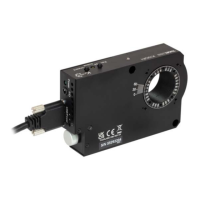48 HA0338T Rev C July 2022
Chapter 6
Abs Move (Trig Rise) – an absolute move (specified using the latest MoveAbsolute or
MoveAbsoluteEx method settings) is initiated on the specified channel when a rising
edge input signal is received on the TRIG IN connector.
Abs Move (Trig Fall) – as above, but the absolute move is initiated on receipt of a
falling edge signal.
Home Move (Trig Rise) – a home move (specified using the latest MoveHome method
settings) is initiated on the specified channel when a rising edge input signal is
received on the TRIG IN connector.
Home Move (Trig Fall) – as above, but the home move is initiated on receipt of a
falling edge signal.
Trig Out
The Trigger Out output can be configured to be asserted to either logic HIGH or LOW
as a function of certain motion-related conditions, such as when a move is in progress
(In Motion), complete (Move Complete) or reaches the constant velocity phase on its
trajectory (Max Vel). The logic state of the output will remain the same for as long as
the chosen condition is true. The logic state associated with the condition can be
selected to be either LOW or HIGH.
The Trigger Out output settings can be persisted and the persisted settings will be
automatically applied once phase initialisation has completed after the next power-up.
Whilst this can be advantageous of in some applications, please note that
immediately after power-up, while the unit is going through its normal boot-up and
initialisation process, the state of the Trigger Out output may not be its expected state.
In addition to the trigger out options listed above, it is also possible to set or clear the
Trigger Out output under software-only control. As with the Trigger In input, this allows
application software to use the Trigger Out output as a general-purpose digital output.
To use this option, select the Trigger Out option to be Disabled and use the
LLSetGetDigOPs method to control the state of the output directly - see the
APTServer helpfile for details on how to use the LLSetGetDigOPs method.
Trigger Out options are set as follows:
Disabled – triggering operation is disabled
In Motion (Trig HI) – The output trigger goes high (5V) when the stage is in motion.
In Motion (Trig Lo) – The output trigger goes low (0V) when the stage is in motion.
Move Complete (Trig HI)
Move Complete (Trig HI) - The output trigger goes high (5V) when the current move
is completed.
Move Complete (Trig LO) – The output trigger goes low (0V) when the current move
is completed.

